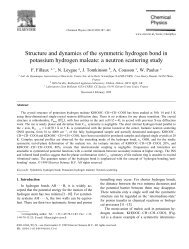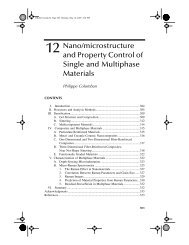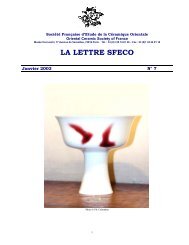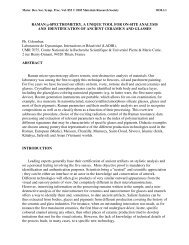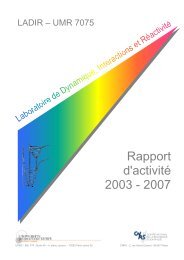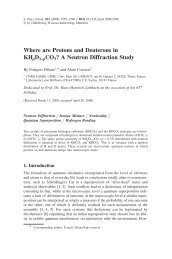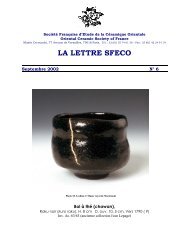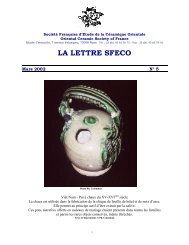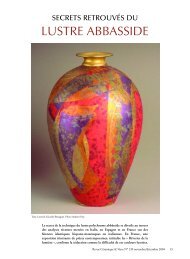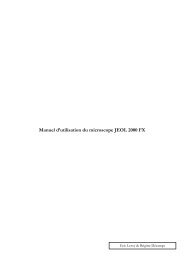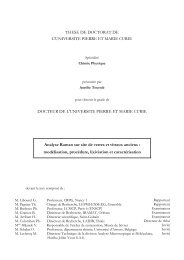Raman Spectroscopy of nanomaterials - institut de chimie et des ...
Raman Spectroscopy of nanomaterials - institut de chimie et des ...
Raman Spectroscopy of nanomaterials - institut de chimie et des ...
Create successful ePaper yourself
Turn your PDF publications into a flip-book with our unique Google optimized e-Paper software.
ARTICLE IN PRESS+ MODELG. Goua<strong>de</strong>c, Ph. Colomban / Progress in Crystal Growth and Characterization <strong>of</strong> Materialsxx (2007) 1e562crystalline contribution120045Δν / cm -10-2-4-6-8-10-121 22'3-14-2 0 2 4 6 8 10 12 14Strain /amorphouscontribution10008006004002000σ/ MPaFig. 27. Comparison <strong>of</strong> the strain <strong>de</strong>pen<strong>de</strong>ncy <strong>of</strong> the crystalline and amorphous low frequency <strong>Raman</strong> contributions (lefthand scale) with the stressestrain tensile curve (right hand scale) for PET fibres. Reprinted from Ref. [172, pp. 2463e2475] with permission from Elsevier.Fig. 5). In PET fibres, most <strong>of</strong> the stress is obviously transferred to the amorphous matrix,whereas nano-crystallites are only slightly compressed by a Poisson’s effect. In polyami<strong>de</strong> fibres,both the amorphous and crystalline moi<strong>et</strong>ies accommodate the stress because the nanostructureputs them ‘‘in series’’. Wavenumberestrain curves then start with a plateau thatcorresponds to the disentanglement <strong>of</strong> the polymer chains (visco-elastic regime) and wavenumbersstart downshifting as soon as ‘‘knots’’ block this process (elastic regime) [169e172].5.5. CNTs used as nanom<strong>et</strong>ric stress gaugesOn account <strong>of</strong> their very small dimension, the direct <strong>de</strong>termination <strong>of</strong> CNTs Young’s modulusis difficult. Most experimental values were obtained through manipulations with an AFMtip (see Table 4 in Ref. [493]) but Lourie and Wagner [494] <strong>de</strong>monstrated that an indirect measurementwas possible using RS on ‘‘quenched’’ matrix-embed<strong>de</strong>d nanotubes. Using a ‘‘concentriccylin<strong>de</strong>rs’’ mo<strong>de</strong>lling <strong>of</strong> each CNT and the surrounding matrix, they calculated the axialtube stress due to cooling by DT <strong>de</strong>grees and established an expression for nanotubes Young’smodulus E NT :E NT ¼ Da DT3 NT1 ð1fNT Þf NTE m ð61Þwhere Da is the difference in thermal expansion, f NT is the volume fraction <strong>of</strong> nanotubes, E mthe Young’s modulus <strong>of</strong> the matrix and 3 NT is the compressive strain. The latter was measuredby the strain <strong>de</strong>pen<strong>de</strong>ncy <strong>of</strong> the D* <strong>Raman</strong> band <strong>of</strong> SWCNTs, which allowed Young’s modulus<strong>de</strong>termination. Conversely, some authors filled composites matrices with nanotubes and usedthem to sense fibre stress in polymers [471,495,496].References[1] Ph. Colomban, Ceramics Int. 15 (1989) 23.[2] Ph. Colomban, G. Sagon, X. Faurel, J. <strong>Raman</strong> Spectrosc. 32 (2001) 351.Please cite this article in press as: G. Goua<strong>de</strong>c, Ph. Colomban, Prog. Cryst. Growth Charact. Mater. (2007),doi:10.1016/j.pcrysgrow.2007.01.001



